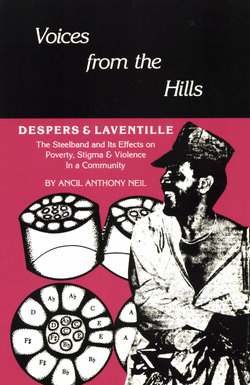Читать книгу Voices from the Hills - Ancil Neil - Страница 9
На сайте Литреса книга снята с продажи.
CHAPTER TWO Researching The Community THE COMMUNITY UNDER STUDY
ОглавлениеGeographical Boundaries
Because of its unique location and physical structure, the geographical boundaries of Laventille are difficult to define and, at times, the subject of controversy.
According to a report dated 1970, it is difficult to define the geographical area of this community. The report also outlined that "there was no such thing as the Laventille area."5 The report reasoned that certain common features which normally define a community do not exist within the geographical boundaries that demarcate Laventille. Instead, the area had divided itself into a series of small pockets which operate as entities.6 These pocket-areas were formerly associated with different steelbands.7 A rough division of these pocket-areas are identified and defined as follows:
| Pocket areas within Laventille | |
| Pocket Area 1. | Picton Road to Plaisance |
| Pocket Area 2. | Plaisance to Foster Street, St. Joseph Road to Besson Street along Picadilly Street to South Quay to Flyover. |
| Pocket Area 3. | Eastern Quarry area. |
| Pocket Area 4. | Southwest area of the East Dry River from Beetham Highway |
| Pocket Area 5. | Shanty Town area (near Flyover). |
| Pocket Area 6. | Northeastern area of the East Dry River from Beetham Highway. |
| Pocket Area 7. | St. Paul Street, Clifton Hill, Lodge Place, Mid-Picadilly to corner of Laventille Road and Prince Street. |
| Pocket Area 8. | Rose Hill, Belgrade Street, Upper Duke Street from Picadilly Street, Jackson Place, Sobrian Place on Laventille Road. |
| Pocket Area 9. | Upper Picadilly, Siparia Hill, (Basilon Street, Calvary Hill—special area). Lower Observatory Street from Lower Quarry Street (including Harpe Place) to North Belgrade Street. |
| Pocket Area 10. | Paul Street, Oxford Street, upper Observatory Street (including Chennette Alley), North and South Hermitage Road to Agostini Street to East. |
The boundaries enclosing these pocket areas were set out as follows:
| Northern | Dry River at Oxford Street into Ovid Street to Rigsby Street where it joins Laventille Road. |
| Southern | Beetham Highway. |
| Eastern | Picton Road |
| Western | Dry River along Picadilly Street to Beetham Highway.8 |
The above description by Servol is questionable for the following reasons:
1.Its boundaries extend outside the true Laventille community.
2.There are too many pocket areas.
3.The area cited by Servol includes the larger area referred to as the 'East Dry River area.' This area includes Laventille and surrounding areas.
The following is the true geographical area of the Laventille community, as verified by members of the community. Most of these members have lived in this area all their lives, and the others a great number of years.
